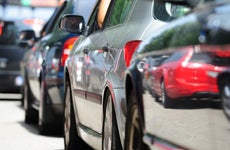The best used cars for teen drivers

The Bankrate promise
At Bankrate, we strive to help you make smarter financial decisions. To help readers understand how insurance affects their finances, we have licensed insurance professionals on staff who have spent a combined 47 years in the auto, home and life insurance industries. While we adhere to strict , this post may contain references to products from our partners. Here's an explanation of . Our content is backed by Coverage.com, LLC, a licensed entity (NPN: 19966249). For more information, please see our .
Finding the right first car for your teen can be challenging. The best first car for teenagers should be affordable and easy to handle, but safety is also a top priority. You may also be looking for a car with efficient fuel economy to save money on gas. Bankrate’s insurance editorial team put together a list of top vehicles for teens with a focus on safety, reliability and value for young drivers.
Good first cars for teens
To find the best cars for teenagers, we started with safety. To make sure we chose safe vehicles, we turned to the Insurance Institute for Highway Safety (IIHS) and the National Highway Traffic Safety Administration (NHTSA), which conduct extensive research into vehicle safety. Each of our vehicles is an IIHS Top Safety Pick.
Next, we looked at the price. Inflation has hit the car market hard, and although prices are falling, they’re still higher than they were a year ago. While we used to suggest vehicles below $10,000, we’ve increased our starting price limit to $25,000 to accommodate the high cost of used vehicles in today’s economy. Pricing information is from Kelley Blue Book data, but keep in mind that prices for used cars are changing rapidly with inflation. We also reviewed each vehicle’s fuel economy to account for fluctuating gas prices. Our research shows these are the top five best cars for teen drivers:
1. Honda Accord
Best for resale value
Average price: $18,000 to $25,000
Fuel economy: 29-37 mpg
Honda Accord gets top marks from the IIHS, and has been a Top Safety Pick+ for the past four years. It has excellent fuel economy, with base models getting nearly 40 miles per gallon on the highway, while a hybrid version offers 41/46 mpg ratings. It holds its value well, with a depreciation rate of about 21 percent for its first five years. New models start at slightly more than $25,000, but used Accords are often available at reasonable prices.
| Perks | Drawbacks |
|---|---|
| Has standard, hybrid and turbo options | No all-wheel-drive option |
| Excellent fuel economy | Base 4-wheel-drive engine has limited power |
2. Toyota Camry
Best for reliability
Average price: $10,000 to $22,000
Fuel economy: 25-32 mpg
The Toyota Camry often ranks near the top of the list as one of the best cars for teenagers and among the best-selling cars nationwide. Camry owners tend to hold onto these vehicles for a long time, indicating that the vehicles remain reliable. While higher-end models may cost over $25,000, it is possible to find a no-frills version for under $25,000 or even less for older models. The 2014 standard gasoline model gets an estimated 28 combined city/highway mpg. IIHS included the Camry as a Top Safety Pick from 2012-2024, and the NHTSA gave the same models five-star overall safety ratings.
| Perks | Drawbacks |
|---|---|
| Hybrid option available in newer models | Smaller-than-average trunk |
| Ranks highly in safety tests | Manual transmission not available on all model options |
3. Nissan Altima
Best for safety
Average price: $8,000 to $34,250
Fuel economy: 25-32 mpg
Every model of the Nissan Altima since 2014 has earned an NHTSA five-star safety rating and is an IIHS Top Safety Pick. Even in the base models, Bluetooth connectivity and Intelligent Key remote engine start are standard features, while models from 2016 and beyond also feature a rearview camera. The vehicle tends to get between 28 and 32 mpg, depending on the model and specific features. Newer models will cost more, although older models may be available for under $10,000.
| Perks | Drawbacks |
|---|---|
| Includes advanced features in the base models | No hybrid version available |
| High safety test scores | Limited headroom in the back seat |
4. Mazda 3
Best for tight budgets
Average price: $8,000 to $27,315
Fuel economy: 23-33 mpg
The base model Mazda 3 starts at around $8,000 for a 2012 model year, making it one of the cheapest cars on our list. At an average of 23 to 33 combined city/highway mpg, the Mazda 3 also has a high fuel efficiency score. Like the other vehicles, the Mazda 3 is an IIHS Top Safety Pick but only received four out of five stars from the NHTSA before 2014; models after 2014 received five stars.
| Perks | Drawbacks |
|---|---|
| Low average prices | Small back seat |
| All-wheel-drive available | Acceleration can be noisy |
5. Subaru Outback
Best for additional room
Average price: $9,000 to $28,000
Fuel economy: 20-28 mpg
The Subaru Outback could be a good choice if you want your teen to have a little more room or need the towing capacity. Despite being a larger model, the Outback gets good mileage, with an average of 20 to 28 combined city/highway mph, depending on the year and trim package. The Outback is consistently an IIHS Top Safety Pick and has a five-star rating from the NHTSA. However, the Outback has had more recalls than the other vehicles on our list.
| Perks | Drawbacks |
|---|---|
| Roomier interior than the other vehicles listed | Several model years have had multiple recalls |
| 3,000 pound towing capacity | The larger size (compared to the others on our list) could mean less maneuverability |
Car insurance for teens
Teen drivers tend to pay more for car insurance than any other age group. Teens have less experience behind the wheel than older drivers and are more likely to engage in risky behavior, including speeding and distracted driving. Because of the higher likelihood of claims, insurers often charge higher rates for teens to compensate. However, teens may be able to find lower rates with some key strategies.
First, carefully think about the car you wish to purchase for your teen. In many cases, domestic-made cars with high safety ratings are cheaper to insure. Standard vehicles also usually cost less to insure than luxury models or sports cars. Shopping around to compare quotes will help you find the cheapest carrier for your young driver, and don’t forget to pay attention to car insurance discounts. Some insurers offer discounts tailored to teens, such as good student discounts or telematics programs.
| Driver age | Average annual full coverage premium |
|---|---|
| 16-year-old | $4,874 |
| 17-year-old | $4,541 |
| 18-year-old | $4,258 |
| 19-year-old | $3,732 |
*Rates reflect the total cost for teens insured on their parents’ policy with one vehicle.
Frequently asked questions
-
-
Car insurance for teens is generally more expensive than coverage for older drivers. Car insurance companies determine rates based on their perception of how much risk they are taking on by insuring someone. According to the Centers for Disease Control and Prevention, vehicle crashes are the leading cause of death for teens in the U.S., and they have the highest rate of accidents of any age group. Teens also lack experience behind the wheel and may engage in unsafe behavior such as texting while driving. All of these factors lead to an increased potential for expensive claims and make insurers more likely to charge high rates for teen driving insurance.
-
There are several organizations, including the Insurance Institute for Highway Safety and the National Traffic Safety Administration, that issue safety ratings for all common makes and models of cars. Ratings are posted on the websites for each of these organizations with details on where models excelled or fell short in testing. Test driving vehicles is a great way to understand whether your teen would feel comfortable and safe in a specific model. During a test drive, have your teen pay attention to how the vehicle handles as well as how they feel about the vehicle’s visibility, features and ease of use.
-
Most states have teenage driving restrictions. Each state sets its nighttime driving restrictions. For example, Nevada restricts teen driving between the hours of 10 p.m. to 5 a.m. Vermont is the only state that does not impose nighttime driving restrictions on teens. According to the CDC, nearly one-third of the fatal accidents involving teens from 2009-2014 happened between 9:00 p.m. and 6:00 a.m. In 23 states and the District of Columbia, driving restrictions begin at midnight or later; other states have earlier restricted times.
-
There’s no single model that is always the safest option for all teens. Any of the cars we’ve listed above is noted for its safety features and could be a good choice for a teen driver. The safest car for your teen is most likely to be one in which they feel comfortable and able to handle competently. A test drive can help ensure that they are able to see clearly around them and use the vehicle’s safety features. You may want to look for cars that offer options like lane departure warnings, automatic emergency braking and adaptive cruise control. The Insurance Institute for Highway Safety, in conjunction with Consumer Reports, issued a list of good vehicles for teens in 2023 that may offer additional options that are good first cars for teens.
-
Methodology
Bankrate utilizes Quadrant Information Services to analyze April 2024 rates for all ZIP codes and carriers in all 50 states and Washington, D.C. Rates are weighted based on the population density in each geographic region. Quoted rates are based on a single, 40-year-old male and female driver with a clean driving record, good credit and the following full coverage limits:
- $100,000 bodily injury liability per person
- $300,000 bodily injury liability per accident
- $50,000 property damage liability per accident
- $100,000 uninsured motorist bodily injury per person
- $300,000 uninsured motorist bodily injury per accident
- $500 collision deductible
- $500 comprehensive deductible
To determine minimum coverage limits, Bankrate used minimum coverage that meets each state’s requirements. Our base profile drivers own a 2022 Toyota Camry, commute five days a week and drive 12,000 miles annually.
These are sample rates and should only be used for comparative purposes.
Teens: Rates were determined by adding teens ages 16-19 to their 40-year-old married parents’ policy. The rates displayed reflect the total cost of a driver this age added to their parents’ policy.
Related Articles




